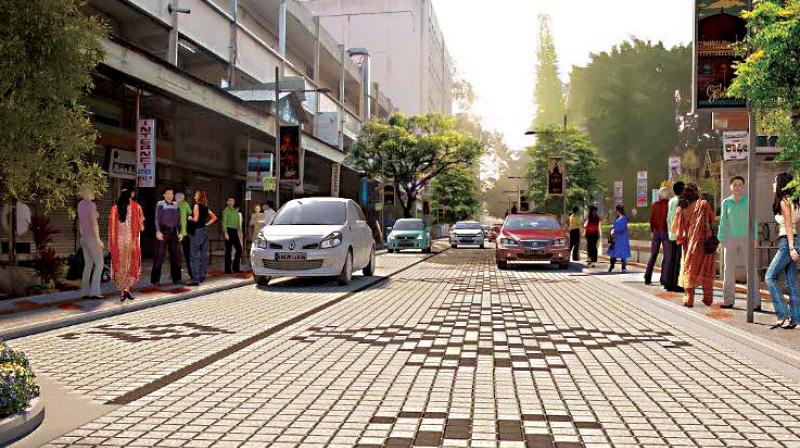On Church Street, it's art beneath your feet
The Kasuti-pattern cobblestones bring local cultural traditions into public spaces.

“It’s the tragedy of the commons,” declared architect and urbanist Naresh Narasimhan, discussing India’s collective lack of ownership towards public spaces. And the Rs 9 crore revamp of Church Street, a pedestrian nightmare with broken pavements and overflowing drains, stands for far, far more than just the fixing of a road.
Narasimhan, whose firm, Venkataramanan Associates is executing the state government-sanctioned project, is bringing aesthetics, that have long since been forgotten, back into urban design. The cobblestones, made from indigenous materials, will include a Kasuti pattern, a tribute to Karnataka's heritage, albeit declining weaving tradition.
The BBMP, whose initiative this is, responded wholeheartedly to the plan. "Full marks to them," said Narasimhan. "They replied immediately, calling it a great idea. It's the first time the Mayor is responding to a design issue. Bengaluru Development Minister K.J. George, he added, "specifically approved the use of cobblestones instead of concrete." Mr George's support, coupled with the efforts of MLA N.A. Haris who helped mitigate the inconvenience caused to commuters during the construction process, will result in a pedestrian experience quite unlike anything India has seen before.
We're trying to bring aspects of local culture into planning the city. Infrastructure is seen as an engineering problem and I'm trying to shift the focus onto urban design," said Narasimhan, who gives credit for the Kasuti pattern to fashion designer Prasad Bidapa. "It started on the Citizens for Bengaluru WhatsApp group. I was looking for patterns, preferably something local and Prasad suggested Kasuti. Nobody connects embroidery with urban design, but that's the gap I'm trying to bridge."
Aesthetics are perhaps the biggest casualty of an increasingly utilitarian approach to urban planning, with local traditions and art forms receding from public life. "Our interiors are as good as anywhere else in the world, but you step out of those spaces and you fall into a ditch full of running sewage. Indians lack a sense of ownership toward public spaces. Cultural references are strong in our interiors - why can't we replicate this in outdoor spaces, too?"
The street is being redesigned using locally-obtained red and white granite, incorporating colours and concepts that exist in our immediate surroundings. The red stones on the pavements reflect the profusion of fertile, iron-rich, soil in Karnataka. "We tend to do boring, grey infrastructure. The Namma Metro, for instance, serves the purpose of transport but not much else. The street art and Western idioms just don't cut it. We're constantly looking to the west for reference when we have a strong culture of our own."
Poor patronage has left Kasuti a dying art, with fewer weavers and artisans carrying the tradition forward. "A lot of people are familiar with the designs and can identify them, but know very little about where the tradition comes from. And the fact that it can be used to beautify a local space is a truly international approach." Our cultural references, says Bidapa, are far removed from what is local. "The Lalbagh project seeks to create a mini Niagara falls. In a Karnataka, the state that's home to the Jog Falls. We don't need to root ourselves to concepts that are alien to us."
And that's not all. Narasimhan, who posted images of the Kasuti pattern cobblestones on Facebook, seems to have ignited something of a trend. "I received a message from someone in Latvia, asking about building streets with cultural references of their own Norse Gods. They're looking for patterns that make sense to them. The idea is to cross traditions from one art form to another and we have plenty of local references to draw from. India has undersold herself and perhaps this will bring her own rich culture to a more visceral level."

